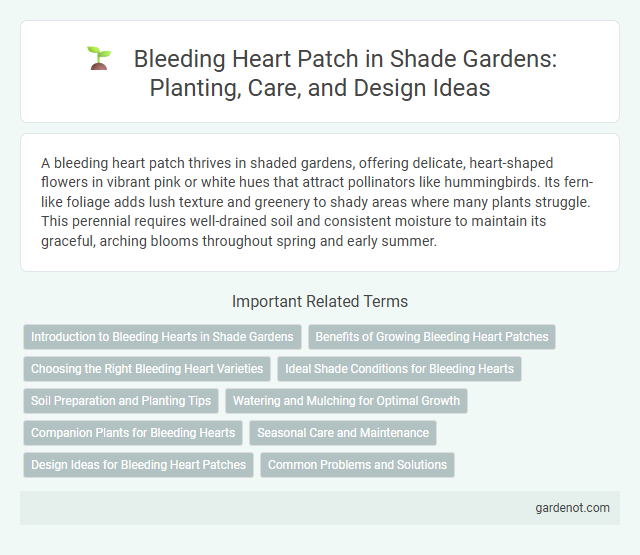A bleeding heart patch thrives in shaded gardens, offering delicate, heart-shaped flowers in vibrant pink or white hues that attract pollinators like hummingbirds. Its fern-like foliage adds lush texture and greenery to shady areas where many plants struggle. This perennial requires well-drained soil and consistent moisture to maintain its graceful, arching blooms throughout spring and early summer.
Introduction to Bleeding Hearts in Shade Gardens
Bleeding heart (Dicentra spectabilis) is a popular perennial choice for shade gardens due to its delicate, heart-shaped flowers and lush, fern-like foliage. Thriving in partial to full shade, it adds a romantic, vintage charm with blooms that typically appear in spring and early summer. This plant prefers well-drained, moist soil and is ideal for understory planting, providing texture and color contrast among ferns and hostas.
Benefits of Growing Bleeding Heart Patches
Bleeding heart patches enhance shade gardens by adding vibrant, heart-shaped flowers that attract pollinators like bees and butterflies, boosting local biodiversity. Their shade tolerance and low maintenance requirements make them ideal for under-canopy planting, improving soil quality through deep root systems. Growing bleeding heart patches also provides seasonal interest with early spring blooms, offering aesthetic value and supporting pollinator populations during critical periods.
Choosing the Right Bleeding Heart Varieties
Selecting the right bleeding heart varieties for a shade garden depends on factors such as hardiness zone, bloom color, and plant size. Popular options include Dicentra spectabilis with classic pink heart-shaped flowers, Dicentra eximia for a more delicate appearance and extended blooming period, and white-flowered Dicentra cucullaria that thrives in woodland shade. Choosing disease-resistant cultivars ensures vibrant growth and reduces maintenance in shaded, moist environments.
Ideal Shade Conditions for Bleeding Hearts
Bleeding hearts (Dicentra spectabilis) thrive in partial to full shade environments, making them ideal for shaded garden patches. These plants prefer moist, well-drained soil rich in organic matter, ensuring root health and vibrant blooms. Avoiding direct afternoon sun prevents leaf scorch and promotes prolonged flowering periods in shade gardens.
Soil Preparation and Planting Tips
Bleeding heart plants thrive in well-drained, fertile soil enriched with organic matter such as compost or leaf mold, ensuring moisture retention without waterlogging. Plant bleeding heart crowns in early spring or fall, spacing them 1 to 2 feet apart to allow room for growth and air circulation. Mulching around the plants helps maintain consistent soil moisture and suppresses weeds, promoting healthy root development in shaded garden areas.
Watering and Mulching for Optimal Growth
Bleeding heart plants thrive in consistently moist, well-drained soil, requiring regular watering to prevent drought stress, especially during dry spells. Applying a 2-3 inch layer of organic mulch such as shredded bark or compost helps retain soil moisture, regulate temperature, and suppress weeds around the plant base. Proper watering combined with mulching enhances root health and supports vigorous growth in shaded garden environments.
Companion Plants for Bleeding Hearts
Hostas, ferns, and astilbes thrive as ideal companion plants for bleeding heart patches, enhancing shade garden aesthetics while maintaining similar moisture and soil requirements. These plants contribute complementary textures and colors, promoting a lush, layered look without competing for nutrients. Incorporating shade-tolerant companions ensures healthy growth and highlights the delicate pink or white blossoms of bleeding hearts in spring.
Seasonal Care and Maintenance
Bleeding heart patches thrive with consistent moisture and well-drained, humus-rich soil during spring and early summer growth phases. After flowering, reduce watering to allow dormancy and prevent root rot, while applying a balanced fertilizer supports healthy foliage. Regularly remove yellowing leaves and trim dead stems in late summer to promote vigorous growth in the next season.
Design Ideas for Bleeding Heart Patches
Bleeding heart patches create striking focal points in shade gardens with their graceful, arching stems and heart-shaped blooms in vibrant pink or white hues. Incorporate bleeding heart plants alongside hostas and ferns to enhance texture diversity and maintain moisture-loving soil conditions vital for their growth. Position these patches near shaded walkways or garden benches to maximize visual impact during spring, emphasizing natural woodland garden aesthetics.
Common Problems and Solutions
Bleeding heart patches often face common problems like yellowing leaves caused by overwatering or poor drainage, which can be resolved by improving soil aeration and adjusting watering frequency. Aphid infestations and slugs are frequent pests; using insecticidal soap and organic slug repellents helps protect the plant. To prevent fungal diseases such as powdery mildew, ensure adequate air circulation and apply fungicides when necessary.
Bleeding heart patch Infographic

 gardenot.com
gardenot.com